Thirteen years ago, Gabe, Pete and Fonzie (hereafter known as the “Three Wise Men”) set forth upon this great continent dedicated to the proposition that speed is good, and that more speed is better – testing whether these motorcycles, or any motorcycles so conceived and dedicated, could long endure. Ah, turns out the answer is yes. Suzuki and Kawasaki are still turning these things out. We’d like to ride them to Mammoth again as soon as they add cruise control.
2006 Rocket Tour – World’s Fastest Imbeciles
2006 Kawasaki ZX-14 and the 2006 Suzuki Hayabusa
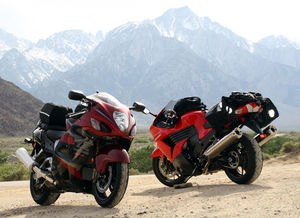 Here we have moved MO to the mountain.
Here we have moved MO to the mountain.What sort of bikes are we talking about here, anyway? At the Kawasaki ZX-14 intro we attended a few months ago, Kawasaki’s media relations people referred to the 190 hp device as a “flagship” sportbike. It’s an expression of the manufacturer’s corporate prowess, a symbol of engineering excellence. When it comes to such a vehicle, engineers are given almost free reign to build the fastest, best-handling, most comfortable and prestigious motorcycles.
The class is a small one. Both Honda and Yamaha have had such bikes in their inventory, but they’ve dropped them for various reasons. Those who remember the YZF1000R have fond memories of a big, stable bike that was comfortable enough to ride all day and had a wicked mid-range and top-end stomp. Alas, Yamaha sold it in the USA for just one year–1997–before replacing it with the razor-sharp and much lighter YZF-R1, which was too much of a focused racetrack tool to be considered a GT-type bike like the YZF1000R.
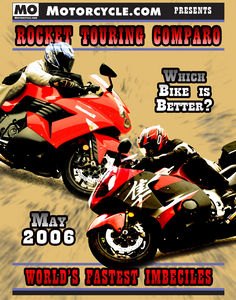
The Honda CBR1100XX Blackbird was Big Red’s last entry into this class, and that was a refined, smooth and comfortable Gentleman’s Express that was also plenty fast–136 hp at the back wheel was unbelievable in the mid-90’s–but it was too refined to get the bad boy reputation a flagship vehicle needs. Like the Viper, Ferrari Enzo or Porsche GT3, a superbike needs to have a whiff of danger to it, enough character and mystique to make it a desirable object.
We all know about the legendary Hayabusa, of course. Introduced in 1999 and reviewed by MO, the GSX-1300R was intended by Suzuki to replace the GSXR-1100 as that firm’s Gentleman’s express, a bike that would be both the most powerful production motorcycle on the planet as well as being light, compact, good-handling and easy to ride. They named it “Hayabusa” after the legendary Japanese falcon that primarily dines on blackbirds. Get it?
No matter how cheesy the joke, or how over-the-top the Salvador Dali melting-clock bodywork looked, nobody could deny the Hayabusa’s comfort, sharp handling and most importantly, smooth and tractable yet frightening power. The Hayabusa has a following from all sorts of riders, from suburban mid-life crises-ers to rap stars who bling out their `Busas in chrome and gold plate.
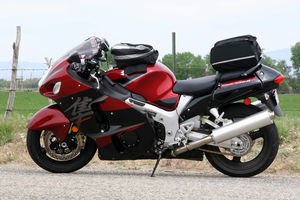 A big old bird ready to fly.
A big old bird ready to fly.Kawasaki didn’t take this lying down and responded in 2000 with the all-new ZX-12R. With an all-new motor and monocoque chassis, the 12R had lots of technical credibility along with a touch more power than the Hayabusa. However, it failed to charm riders the same way the Suzuki did, even after a significant revamp in 2002. It had a reputation for being too big, heavy, long and uncomfortable and never really won the love it deserved. The Hayabusa ruled the roost for year after year, with no competition in sight.
All that changed in 2006 when Kawasaki announced a completely new bike, the ZX-14. We covered the technical details in our press intro story, revealing an all-new monocoque chassis and all-new 1352 cc motor that was more compact than the 1198 cc mill it replaced. Pop it on the dyno and 171 horsepower is speedy-deliver-ied to the back wheel, trouncing the anemic 159 hp of the `Busa.
Is it just about power? If you think so, you can stop reading now and turn to more productive time-wasting. But if you think a motorcycle is more than just numbers and want to know how these two bikes fared against each other on the open road, around town, and in the canyons, keep reading.

Ali v. Frazier Battle it Out for Heavyweight Championship of the World
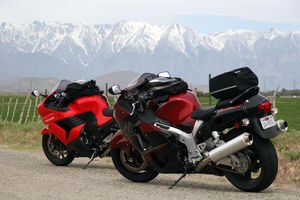 How will they fare on the open road?
How will they fare on the open road?We at MO, a long time ago, would have put heavyweight sportbikes like these out on the racetrack to find out which was best. However, neither of these bikes are intended as racetrack weapons, so it would be unfair to put them there. They’re built for high-speed sport-touring, so we drew up a route going halfway across California, on all kinds of roads, from straight and boring to tight, twisty and bumpy. We went from the foggy gloom of the coastal marine layer to the roasting heat of the Mojave Desert, to the snow-bound mountains above 7,000 feet and back.
After hundreds of miles of evaluation and saddle time, we think we have a handle on what bike is good for what and which bike we’d buy for our money. We’ll examine each bike a little closer, discuss its strengths and weaknesses, and pick a winner, based solely on the all-important MO criteria of what we’d buy with our money.
.jpg)
2006 Kawasaki ZX-14:
The Young George Foreman Invents the Fat-Free Home Grill
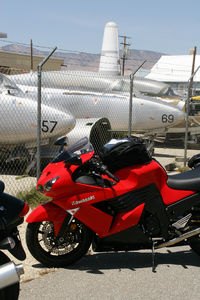 “Warp Factor 14!”
“Warp Factor 14!”All-new for 2006, the Kawasaki Ninja ZX-14 delivers a knockout punch with comfort, smoothness, ease-of-use and the most powerful engine ever fitted to a production street motorcycle.
We attended the launch of this significant new model not too long ago, and you can read about its more distinctive technical aspects there. We’ll quickly highlight some of its more important differences from its rival.
While the Hayabusa relies on a more traditional frame, the Ninja uses a second-generation “monocoque” chassis made from aluminum sheets welded together to form a rigid structure. Kawasaki claims this is more rigid than twin-spar designs; we think it’s to keep bulk, weight and cost down ourselves. The chassis locates the 190-section rear wheel and tire in an extra-long swingarm. Wheelbase is a compact 57.5″, compared to the Hayabusa’s 58.5″ stretch, and the entire package weighs in at a claimed dry weight of 474 pounds, four pounds less than the Suzuki’s claimed dry weight.
Hanging under that frame is a compact 1352 cc four-cylinder with a shorter stroke and bigger bore than the `Busa’s. It also sports dual gear-driven counterbalancers for extra smoothness at high rpms. Compression is a point higher than the Suzuki, at 12.0:1. It’s all good for 171 hp and 105 foot-pounds of torque at the back wheel on MO’s Dynojet Dyno.
Brakes and suspension are special, too. A 43 mm inverted cartridge fork adjustable for preload, rebound and compression damping sits up front, with a three-way adjustable shock working with a linkage in the back. Rake is 23 degrees, and trail is 3.7 inches, compared to the Busa’s 24 degrees of rake and 3.8 inches of trail. The front Bridgestone BT-014 is mounted on an aluminum three-spoke rim with 310 mm “petal” rotors grabbed by radial-mount four-piston calipers with one pad on each caliper. The brake and clutch master cylinders are also radial jobs.
It’s encased by a sleek fairing festooned with thematic styling touches like the heel guards and engine louvers. The double headlamp cluster is aggressive looking, while the high windscreen promises good wind protection. Dual analog clocks display speed and RPM below a huge rider information display. A programmable shift and launch light aid beginnner dragracers.
This engine could easily be used as a time travel device with its ability to seemingly warp time…
Our test unit was finished in Kawasaki’s Passion Red paint scheme, a color metrosexual Senior Editor Gabe Ets-Hokin found “very sexy.” We enjoyed the aggressive, integrated design of the bike: “the bike seems to be one piece from front to back”, according to Editor Pete Brissette. It looks low, sleek and menacing, with a shape that says “I go fast” even when standing still.
Once aboard, the rider is greeted by a very humane riding position and soft seat. Pete declared the “Ninja makes eating the miles a pleasure”, with a well-proportioned saddle, clip-on and foot peg relation. Pete “never felt cramped, and any discomfort from holding the throttle or sitting came on far later in the trip than it would have on most other bikes, short of touring-oriented machines I’ve ridden.” Gabe agreed, although he thought the seat was too soft and could use firmer foam. The wind-tunnel designed fairing and windscreen gives great wind protection, for the taller frame of photographer and web guru Alfonse “Fonzie” Palaima as well as our editorial stunt-dwarf team.
The motor fires up easily and cleanly, with no hint of stumble or slow warm-up, regardless of altitude or atmospheric conditions. It’s also incredibly smooth and powerful: Gabe called it a “bottomless, all-you-can-eat shrimp and lobster buffet of power”, and Pete speculated that “this engine could easily be used as a time travel device with its ability to seemingly warp time”. Pete pointed out that this bike is “approaching 120 mph in second gear”, before redline. We at MO think this is both absurd and sublime.
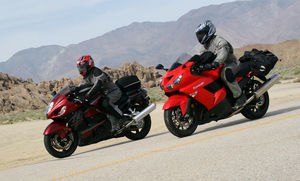 This is both absurd and sublime.
This is both absurd and sublime.Fueling was flawless, with the exception of what we speculate must be a built-in flat spot in the power curve around 3,500 to 5,000 RPM (doubtlessly to help prevent the ZX-14 from being worn as a hat by nascent drag-racers). It’s most noticeable when trying to pull a clutch-less wheelie from low speeds. Some of the more with-it drag-racing types at the Ninja’s press intro said this was programmed into the ECU and that it could be fixed with wire-cutters.
A minimal amount of vibration found its way up through the foot pegs and clip-ons, but the motor was so smooth we often rode for dozens of miles before realizing the transmission was in fifth or even fourth gear at 80-plus MPH. The gear-position indicator is very handy for just this reason; Gabe said the motor “felt almost the same in any gear, regardless of speed or RPM.” That transmission worked flawlessly, too; Pete complained of a “minimal amount of lash” that Gabe attributed more to the “wheelie wire” issue, but was impressed with how perfectly the cogs snicked from gear to gear. The clutch is also a thing of wonder, with sensitivity and feel usually not found in hydraulic clutches.
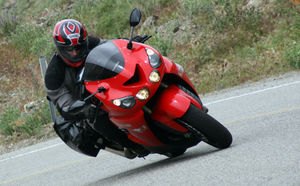 Pete carrying some corner speed…
Pete carrying some corner speed…The ZX-14 offered a very plush ride while droning down the freeway. It did an excellent job of isolating most road imperfections from the rider, although some high-speed bumps could produce a sharp jolt through the front end, possibly from too much compression damping. Potholes, bumps, expansion joints or whatever, on the whole the big Ninja provided a great ride on all kinds of road surfaces and would be flawless with a bit of fine-tuning.
Once off the interstate and on the two-lane roads, the ZX-14 shows a measure of handling prowess unexpected in a machine this heavy. Gabe and Pete agreed that initial turn-in was surprisingly quick, but Pete noticed that “large changes in direction require more energy from the rider, and the ZX doesn’t snap from left to right nearly as quick as the ‘Busa.” Gabe just thought the 14 felt larger, heavier, and not as responsive as the Suzuki did, despite its sportier rake, trail and wheelbase numbers. The bike responds without complaint to things like mid-corner line changes or braking, but it lacks the knife-edge precision feel that the Hayabusa has.
At higher speeds, the Ninja has the lead. Gabe said “the bike is stable in turns at triple-digit speeds, making riders feel confident, where on a lesser bike they’d be assuming crash positions.” Al discovered that “never before have I taken a turn as fast as I had on this bike.” The stout chassis, sorted suspension and general gravitas of the big bike convert high-speed sweepers into amusement park rides.
Luckily, the brakes are fully up to this kind of challenge. It’s a similar setup to the ZX-10R, with radial-mounted calipers (sporting one pad per caliper) and a radial-pumping master cylinder and 310 mm petal rotors, but for some reason these brakes are more memorable. That’s probably because we’re comparing them to a seven year-old system on the Suzuki, but these are really great brakes, and we at MO love good brakes almost as much as we love big power. On a twisty road, loaded with luggage and maybe even a passenger, you will appreciate these stoppers, which help you feel confident and in control at all times.
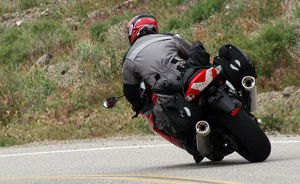 …and there he goes the other way.
…and there he goes the other way.Pete summed it up for all of us: “Short of expensive after-market systems, I haven’t used a better set of binders. They offer incredible power and sensitivity; one finger at almost any speed would haul the bike in. If only the other OEMs would install such perfect brakes.” Gabe compared their effect to “running into a vat of tapioca pudding”. We have no doubt that an updated Hayabusa would include the wondrous brakes installed on the GSXR 1000, but for now the ZX-14 clearly has the superior binders.
Put it all together and you have an outstanding package from Kawasaki. The ZX-14 is smooth, comfortable for long trips, handles well enough to be fun, and looks really cool. The only real complaints–when compared to the Hayabusa–are its slightly heavy-feeling low-speed handling manners and the flat spot in the power curve we noticed. These issues can either be fixed or ridden around, leaving a very satisfied owner to enjoy what is the most powerful production motorcycle and at the same time a refined, comfortable, all-day sporting machine.
.jpg)
The post Church of MO: 2006 Rocket Tour – World’s Fastest Imbeciles appeared first on Motorcycle.com.
【Top 10 Malaysia & Singapore Most Beautiful Girls】Have you follow?